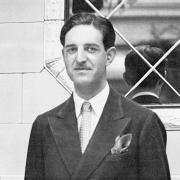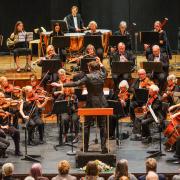For almost 25 years the crew of the North West Air Ambulance have provided life-saving care and treatment at the scenes of emergencies. Taking the hospital to the patient, and carrying out emergency procedures wherever their care is needed.
The weeks leading up to any form of serious surgery can be traumatic and frightening but despite the fear, there’s the comfort that you will be treated in a spotless theatre by experienced experts.
But imagine discovering unexpectedly that you need the procedure urgently and that, while the experts will still be there, it will be carried out beside a busy road, or on a city centre street.

In the daily challenges faced by the North West Air Ambulance, while thankfully not common, it's certainly not unusual.
Some of us have unknowingly been within yards of such medical treatment going on – maybe while held up on a closed motorway at the scene of an accident, or the other side of police line tapes in a city centre, paces from a sea of medics and emergency vehicles following an assault, stabbing or shooting.
The common factor is that in each case somewhere nearby there will be a North West Air Ambulance helicopter or fast-response car, each crewed by a Helicopter Emergency Medical Service (HEMS) doctor or consultant and paramedic.
The charity was founded in 1999 and takes the hospital to the patient. The NWAA HEMS appears to be a high-speed ambulance that swoops in and gets an accident victim to the nearest hospital pronto but in many cases the NWAA helicopter is bringing Accident & Emergency to the roadside, field, fell, beach or city centre.

Not every incident involves major surgery, but most times they attend it's for something potentially life-saving.
‘Doctors can do at the roadside things which not long ago went on only behind curtains and doors in hospitals – a thoractomy, for instance,’ says NWAA paramedic Rob - emergency medicine practitioners do not reveal their surnames.
A "thoractomy"? Fundamentally, it involves a doctor surgically opening somebody's chest and carrying out treatment to the heart or lungs, following, for instance, a shooting or stabbing.
‘That's still actually a high-end procedure in a hospital, but the HEMS team can do it by the roadside,’ says Rob.
So unexpected is such action that one of the first things out of each HEMS emergency surgical pack is a piece of paper which is handed to a police officer or firefighter which they are then told to read out, clearly and loudly, not just to by-standing members of the public, but other emergency services members at the scene.

That piece of paper states that a doctor is about to perform surgery, and it's time to look away. By all accounts, the reaction to it being read out loud can sometimes be as much of a shock as the activity going on, usually masked by staff holding blankets, but sometimes very visible.
And all the while this is going on, a blood transfusion could also be happening, highlighting another surprisingly recent innovation previous restricted by technology limitations: HEMS helicopters carry blood products, but only since 2019.
The tech challenge had been getting necessarily-chilled blood, stored on the heli, from around 5 degrees C to around 37 degrees C in a matter of seconds between storage bag and patient's vein. A simple piece of equipment, costing £150, 10cms long, warms the blood, and can be the difference between life and death.
Another piece of kit which has made a big difference to the team since 2017 is the LUCAS Chest Compression system. ‘If I had to choose any piece of kit this would be one of them. It’s a device that provides automated CPR to patients, freeing up the crew member to carry out other examination or treatment,’ adds Rob.

‘We carry ultrasound scanners now, an amazing portable technology, which was at one point only available at a hospital – they were big machines but are now the size of a mobile phone. You can get ultrasound images of the heart, lungs, abdomen at the scene.
‘Technology helps massively, right from the despatch process, right through to tech we have to guide us to the job, through to sophisticated monitors once we get to the scene; and we can transfer all those observations to databases for records, audit and debrief afterwards,’ says Rob.
Much of the tech carried by a HEMS is the product of technology driven by the wants and needs of the military on the battlefield.
In the early days of helicopter air ambulances, in the late 1990s and then quite a way into the 2000s, choppers were race-against-time patient transport. And even today, a casual look inside NWAA's three Eurocopter EC 135 helicopters – which, incidentally, are equipped with get-out-of-the-way blue flashing lights – can be something of an anti-climax: the starkness and functionality that is workaday aviation, and an unimpressive-looking collection of bags labelled in terms only those who need to know, know. A North West Ambulance Service ambulance looks Star Trek by comparison.

But appearances can be deceptive. That pile of bags in a HEMS heli is a hospital. Those bags pack mighty life-saving power. The equipment, meanwhile, is matched like-for-like in NWAA's emergency road vehicles which operate either in tandem with the helicopters, or, when circumstances or weather dictate, on their own.
In the early days paramedics and ambulance technicians flew to accident or incident scenes and attended to victims and deployed astonishing care and expertise as part of preparation to get that victim to hospital. But the emphasis was on getting the victim to hospital, and the limitations were what those paramedics could do as permitted by their qualifications.
Until 2017 treatment was often limited to paramedics using certain drugs and treatments, but the arrival of HEMS consultants meant not only could they prescribe, on scene, a much broader range of drugs, but they could also use surgical skills.
This is when the hospital really came to the patient at the roadside or off-grid accident: on a day in August 2017, instead of NWAA taking people to hospital, a pendulum swung and it started bringing the hospital to the scene. "Life-changing" doesn't do justice.
Today, NWAA has 21 consultants doing a number of HEMS shifts a month, who are otherwise employed in hospitals around the region, plus 18 full-time employed paramedics.

‘August 2017 was when doctors joined NWAA, when HEMS consultants started to operate what we call enhanced pre-hospital care, which can be anything above standard paramedic practice, but we refer to it as high-end critical care that's offered by doctors who fly – they're all HEMS consultants.
‘Prior to that there was paramedic aircraft, some doctors, but not operating at the same level or with the same type of skills. This was the big step. Since then, further advances and changes have been happening.
‘Back in 2017, HEMS consultants were immediately able to offer 'pre-hospital emergency anaesthesia' - PHEA - that's one of the real headline interventions. It's a drug-assisted intubation, so if you get somebody, for example, at the roadside with a head injury, you have drugs which render them unconscious and then can have an airway tube inserted to mechanically ventilate them, so it's about preserving their airway, maximising oxygenation, creating a physiologically favourable environment for them, which helps to reduce the impact of, for instance, secondary brain injury, makes them more stable and makes it safer to transport them longer distances perhaps to the right hospital,’ says Rob.
‘Before that date, it could sometimes be that they could go straight to the hospital they needed to go to, or they could need to go to a nearer hospital to have a procedure there, and then be transferred on. Best case scenario enabled us to bypass that interim hospital and get them to the hospital where they need to be. And we're bringing forward the therapeutic benefit of that procedure by doing that. All those physiological benefits we're bringing forward in time give that person longer in that phase of better optimisation.’
An influential fact in changes occurring was when getting a pre-hospitalisation anaesthetic within 45 minutes became an emergency medicine target back in 2016.
‘We know that optimising these physiological variables sooner rather than later is beneficial,’ adds Rob. ‘It allows you to get to the right hospital in a better condition. We do know that transferring from one hospital to a more suitable hospital is not generally associated with a better outcome. It's better to get to the right place first.’

This is why HEMS helicopters can often be seen landing at accident scenes which appear to be close to a hospital: that hospital may not have the resource or specialisation identified as a requirement by first responders. The NWAA helicopters can get to the right hospital in minutes when a road ambulance might take closer to an hour.
We often hear of "the golden hour" of initial treatment, but technology and speed of response means "the platinum ten minutes" is a frequent NWAA mantra.
Technology and medical capability have long since overtaken the capacity for human-in-the-street understanding. The thing is, the NWAA HEMS professionals have no time to be wowed by progress: they embrace and deploy every innovation.
Flying NWAA may be an exclusive club that nobody would like to join, but those who have are grateful they did.



























